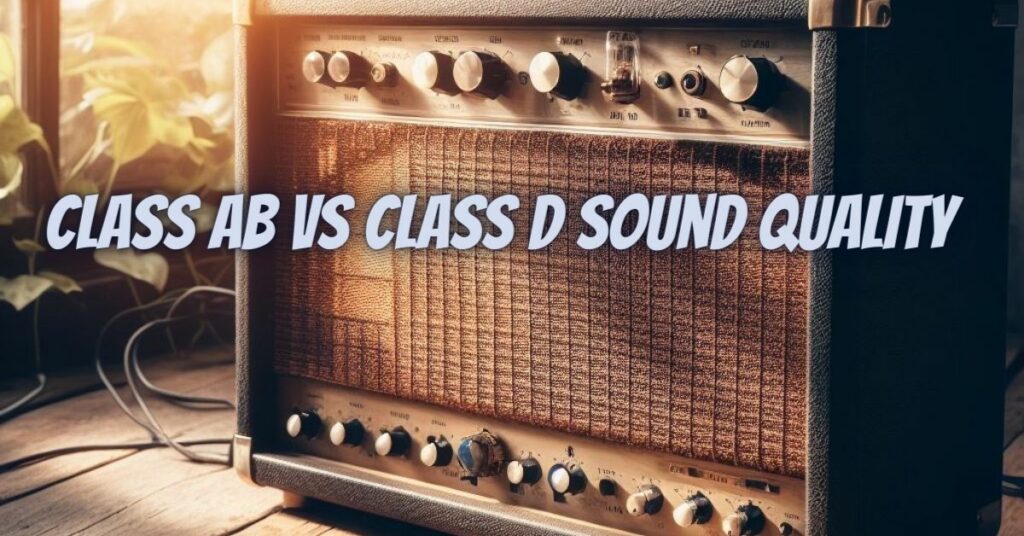When it comes to selecting an amplifier for your audio system or musical instrument, understanding the differences between amplifier classes is crucial. Two common amplifier classes, Class AB and Class D, offer distinct advantages and trade-offs. In this article, we will explore these amplifier classes in-depth, focusing on their impact on sound quality, helping you make an informed decision based on your audio preferences and requirements.
Amplifier Classes Overview
Before we delve into the specifics of Class AB and Class D amplifiers, let’s briefly review their general characteristics:
- Class AB Amplifiers: Class AB amplifiers are known for their balance between efficiency and sound quality. They combine elements of Class A (low distortion) and Class B (efficiency) operation. They are widely used in consumer audio and professional applications due to their versatility.
- Class D Amplifiers: Class D amplifiers, also known as digital or “switching” amplifiers, use pulse-width modulation (PWM) to recreate audio signals. They rapidly switch the output transistors on and off, making them highly efficient. They are commonly used in portable devices and subwoofers.
Class AB Amplifiers and Sound Quality
Class AB amplifiers offer several characteristics that contribute to their sound quality:
- Linearity: Class AB amplifiers provide excellent linearity, resulting in minimal distortion and accurate reproduction of the input signal. This makes them suitable for high-fidelity audio applications.
- Natural Sound: The analog operation of Class AB amplifiers is favored by audiophiles for its warm and natural sound. They can reproduce the subtle nuances and details in music, making them ideal for critical listening.
- Versatility: Class AB amplifiers can handle a wide range of frequencies and are capable of reproducing both delicate highs and powerful lows, making them versatile for various musical genres.
- Transient Response: They excel at handling transient signals, ensuring that quick changes in audio, such as drum hits or guitar plucks, are accurately reproduced without distortion.
Class D Amplifiers and Sound Quality
Class D amplifiers offer their unique characteristics that influence sound quality:
- Efficiency: Class D amplifiers are highly efficient, which means they waste very little power as heat. This efficiency makes them suitable for portable devices and applications where power conservation is essential.
- Compact Size: Their efficiency allows for compact designs, making them suitable for space-constrained applications.
- Sonic Purity: Class D amplifiers can offer excellent sound quality, especially in the bass frequencies, where efficiency is most critical. The digital operation can provide clean and tight bass response.
- High-Frequency Accuracy: Class D amplifiers can reproduce high-frequency audio accurately, making them suitable for applications like home theater systems.
Choosing Between Class AB and Class D for Sound Quality
When choosing between Class AB and Class D amplifiers for sound quality, consider the following factors:
- Audio Application: If you prioritize audiophile-grade sound quality in a home audio system, a Class AB amplifier may be preferable due to its natural and warm sound reproduction.
- Efficiency and Portability: For portable devices or applications where power efficiency is essential, a Class D amplifier can deliver excellent sound quality with minimal power consumption.
- Budget: Consider your budget, as Class D amplifiers are often more cost-effective due to their efficient design.
- Musical Genre: Think about the type of music you listen to or perform. If you need tight, punchy bass, Class D amplifiers can excel in reproducing low frequencies with precision.
The choice between Class AB and Class D amplifiers ultimately depends on your audio preferences and specific requirements. Both amplifier classes offer unique qualities, and when used appropriately, they can deliver exceptional sound quality. Whether you prioritize sonic purity, efficiency, or versatility, understanding the differences between these amplifier classes will help you make an informed decision that enhances your audio experience.


